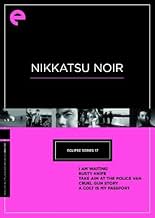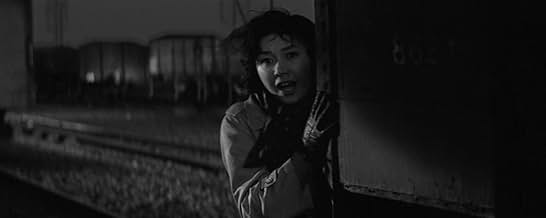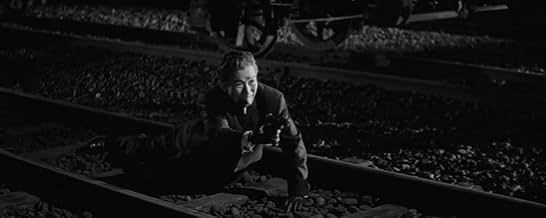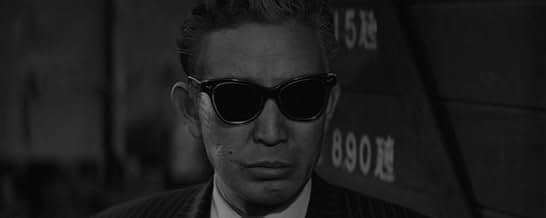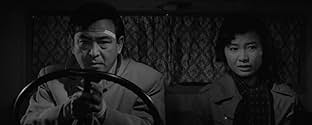Visez cette voiture de police
Titre original : 'Jûsangô taihisen' yori: Sono gosôsha o nerae
NOTE IMDb
6,6/10
1,4 k
MA NOTE
Ajouter une intrigue dans votre langueA prison truck is assaulted and the two convicts inside are murdered. The prison guard on duty gets suspended for negligence and takes it upon himself to track down the killers.A prison truck is assaulted and the two convicts inside are murdered. The prison guard on duty gets suspended for negligence and takes it upon himself to track down the killers.A prison truck is assaulted and the two convicts inside are murdered. The prison guard on duty gets suspended for negligence and takes it upon himself to track down the killers.
- Réalisation
- Scénario
- Casting principal
Avis à la une
Great opening, but got messy quickly, and ultimately was an unsatisfying 79 minutes. The frumpled lead character (48 year old Michitaro Mizushima) reminded me a little of Glenn Ford in The Big Heat and the befuddling, often nonsensical plot reminded me of The Big Sleep, but Seijun Suzuki's work lacks the star power and atmosphere of those films. Questions piled up for me as I watched, and not just about the sequence of events from one scene to the next, but about basic character motivations for pretty much all of these people. The grand reveal of Akiba near the end was silly and a letdown too.
I never began actively disliking it though, because I never really knew what Suzuki was going to put on the screen next. There's a topless stripper shot in the chest with an arrow, and a James Bond like escape from an attempted execution (when of course a simple bullet would have made so much more sense). One of the mysterious young women being tracked down loves American rock 'n' roll, and has a gang of teenage friends pile out of car to protect her. There are several murders, but the main character believes in the goodness in people, and improbably the beautiful young femme fatale (Misako Watanabe) softens and falls in love with him. It's an absurdity set to a jazzy soundtrack and doesn't really work, but somehow held my interest. You can do better though.
I never began actively disliking it though, because I never really knew what Suzuki was going to put on the screen next. There's a topless stripper shot in the chest with an arrow, and a James Bond like escape from an attempted execution (when of course a simple bullet would have made so much more sense). One of the mysterious young women being tracked down loves American rock 'n' roll, and has a gang of teenage friends pile out of car to protect her. There are several murders, but the main character believes in the goodness in people, and improbably the beautiful young femme fatale (Misako Watanabe) softens and falls in love with him. It's an absurdity set to a jazzy soundtrack and doesn't really work, but somehow held my interest. You can do better though.
This is one violent (not in gore as it is brute force intensity), gritty film-noir (part of the "Nikkatsu Noir" set from Eclipse/Criterion) that has a helluva hook - a prison van carrying a couple of peeps is driving at night and two criminals knock a truck in its path to stop the van and then shoot to kill. In the aftermath, one of the guards, Tamon (Mizushima, strapping and no BS male star for Japan if I ever saw one, a bit like a Japanese Mitchum or Glenn Ford), takes it on himself to investigate who was behind it, and it leads him into an 'Agency' that pimps out young women among other nefarious crimes (and what does Tsunaka Ando, played by Shiraki, have to do with it all, or does she even know?)
What makes Seizuki's direction so palpable and involving is how he manages to find some stylistic flourishes while keeping this tight 79 minute story moving; there's this one superbly edited bit where Tamon is walking down a street and Seizuki cuts from him and his grim-determined profile and these four young ladies singing along to a pop song on a jukebox. You think he's recognized the young woman he's been after, he followed her and lost her in a previous scene (those darn graveyards will get ya), but it's not till just a slight beat after he goes by her that he does a double take and recognizes her (and her him) and as he lunges for her she gives a look and the other girls pounce on him. It's extremely clever direction placing us in suspense we aren't even sure will come about, and then it ends on a tussle that is more funny than thrilling (and that's good sometimes!)
Take Aim at the Police Van (one of my favorite titles of all time for the record) doesn't have the most original supporting characters, mostly low life thugs and pissants who may only best Tamon because they're a step ahead of him, and even Shiraki is mostly there to get tense when questioned and then fold pretty quickly thereafter. But the mystery is drawn out without any extra fat on the spine, when characters (mostly Tamon but eventually some others in his orbit) are in danger and are either trapped or fending for their lives it feels like anything can happen, and Seizuki understands widescreen can be used formidably for creating spaces and tension and also for an impactful, once or twice nearly iconic close up (like the sunglasses when we get to see them on the man).
Maybe it is "minor" when compared to Branded to Kill, but that's a tall bar to clear and this is perfectly entertaining B moviemaking all on its own - with an ironic twist ending, but one that means to end more on a surprising emotional beat than a simple "gotcha.
What makes Seizuki's direction so palpable and involving is how he manages to find some stylistic flourishes while keeping this tight 79 minute story moving; there's this one superbly edited bit where Tamon is walking down a street and Seizuki cuts from him and his grim-determined profile and these four young ladies singing along to a pop song on a jukebox. You think he's recognized the young woman he's been after, he followed her and lost her in a previous scene (those darn graveyards will get ya), but it's not till just a slight beat after he goes by her that he does a double take and recognizes her (and her him) and as he lunges for her she gives a look and the other girls pounce on him. It's extremely clever direction placing us in suspense we aren't even sure will come about, and then it ends on a tussle that is more funny than thrilling (and that's good sometimes!)
Take Aim at the Police Van (one of my favorite titles of all time for the record) doesn't have the most original supporting characters, mostly low life thugs and pissants who may only best Tamon because they're a step ahead of him, and even Shiraki is mostly there to get tense when questioned and then fold pretty quickly thereafter. But the mystery is drawn out without any extra fat on the spine, when characters (mostly Tamon but eventually some others in his orbit) are in danger and are either trapped or fending for their lives it feels like anything can happen, and Seizuki understands widescreen can be used formidably for creating spaces and tension and also for an impactful, once or twice nearly iconic close up (like the sunglasses when we get to see them on the man).
Maybe it is "minor" when compared to Branded to Kill, but that's a tall bar to clear and this is perfectly entertaining B moviemaking all on its own - with an ironic twist ending, but one that means to end more on a surprising emotional beat than a simple "gotcha.
Film 3/5 in the Nikkatsu Noir boxset I'm working through, and I'd rank this behind Rusty Knife (film 2/5), but ahead of I Am Waiting (film 1/5).
I'll give it this: Take Aim at the Police Van has a great title and a great opening- both work well to get you hooked early to the simple premise (prison guard is partially blamed for deaths that weren't his fault, so he goes looking for the real killers himself) that soon balloons out and gets very complicated.
While some of the complexity and mystery is intentional, given the main character doesn't really know what's going on much of the time, I think it may have left the audience in the dark just a little too much. You could say that about a lot of classic noir, though- I think it's The Maltese Falcon where the writer even admitted he didn't really understand 100% of the plot.
(EDIT: legend actually goes that it was The Big Sleep where the screenwriters were confused by what they were writing. Do remember Maltese Falcon also having a confusing plot, for what it's worth)
But in any event, it stays entertaining because of the fast (if almost a little too quick) pace, the stylish direction, and some exciting sequences. Plus the mystery is a pretty decent one.
It all makes for an overall solid watch.
I'll give it this: Take Aim at the Police Van has a great title and a great opening- both work well to get you hooked early to the simple premise (prison guard is partially blamed for deaths that weren't his fault, so he goes looking for the real killers himself) that soon balloons out and gets very complicated.
While some of the complexity and mystery is intentional, given the main character doesn't really know what's going on much of the time, I think it may have left the audience in the dark just a little too much. You could say that about a lot of classic noir, though- I think it's The Maltese Falcon where the writer even admitted he didn't really understand 100% of the plot.
(EDIT: legend actually goes that it was The Big Sleep where the screenwriters were confused by what they were writing. Do remember Maltese Falcon also having a confusing plot, for what it's worth)
But in any event, it stays entertaining because of the fast (if almost a little too quick) pace, the stylish direction, and some exciting sequences. Plus the mystery is a pretty decent one.
It all makes for an overall solid watch.
Take Aim at the Police Van is action-packed, fast-moving Japanese Noir. Perhaps though, it's a little too fast moving. And unfortunately employs some rather erratic editing.
The story itself has all the makings of a good noir-ish detective murder mystery. Daijirô Tamon (Michitarô Mizushima) is a prison guard who has convicts murdered during a prison transfer. Tamon decides to hunt down those responsible. He quickly stumbles upon an "agency" that supplies young women as "showgirls" and "masseuses". There is no need to read between the lines or even get metaphorical as the fact they are being used as call-girls is blatantly evident. However, Tamon begins to have feelings for the agency's madam, Yûko (Misako Watanabe).
Directed by Seijun Suzuki, Take Aim at the Police Van builds up a good mystery and adds in a number of chases and shooting sequences. Yet the speed of the story and the choppiness of the editing truly shows that this was simply another movie quickly being fed through the Nikkatsu Studios machine. As swiftly Tamon decides to solve the case, the source of all the woe is discovered (also, such identity is not a shock), and the credits roll.
Take Aim at the Police Van is faster than service at a ramen house. But also quite tasty.
The story itself has all the makings of a good noir-ish detective murder mystery. Daijirô Tamon (Michitarô Mizushima) is a prison guard who has convicts murdered during a prison transfer. Tamon decides to hunt down those responsible. He quickly stumbles upon an "agency" that supplies young women as "showgirls" and "masseuses". There is no need to read between the lines or even get metaphorical as the fact they are being used as call-girls is blatantly evident. However, Tamon begins to have feelings for the agency's madam, Yûko (Misako Watanabe).
Directed by Seijun Suzuki, Take Aim at the Police Van builds up a good mystery and adds in a number of chases and shooting sequences. Yet the speed of the story and the choppiness of the editing truly shows that this was simply another movie quickly being fed through the Nikkatsu Studios machine. As swiftly Tamon decides to solve the case, the source of all the woe is discovered (also, such identity is not a shock), and the credits roll.
Take Aim at the Police Van is faster than service at a ramen house. But also quite tasty.
A 1960 police actioner from writer/director Seijin Suzuki (Branded to Kill/Tokyo Drifter) about a disgraced prison guard, Michitaro Mizushima, who loses some of his charges during a shootout during a nighttime transfer. Taking the law into his own hands but also at some point in the story cops are brought in, Mizushima tracks down the players behind the act siding up to the moll of one of the crooks in the hopes of getting back some dignity he suffered from the escape. As per Noir Alley's host Eddie Muller, the film was a revelation to Japanese audiences, especially the younger sect, which embraced the film embarrassing the honchos at the film studio but now 64 years after the fact the film is fine but ultimately safe when a lot of the gunfights which may've lit a fire under the viewing public butts now feel like so much uncontrolled chaos but the throughline of the plot is solid enough though.
Le saviez-vous
- AnecdotesA trail of gasoline poured on the ground as depicted here, would burn at only about three miles per hour, or about the pace of a brisk walk. This velocity was tested on Trail Blazers (2007).
- GaffesIn the opening scenes, the prisoner's handcuffs are so loose that he could easily slip his hand through.
- ConnexionsFeatured in Best in Action: 1960 (2018)
Meilleurs choix
Connectez-vous pour évaluer et suivre la liste de favoris afin de recevoir des recommandations personnalisées
Détails
- Date de sortie
- Pays d’origine
- Langue
- Aussi connu sous le nom de
- Take Aim at the Police Van
- Société de production
- Voir plus de crédits d'entreprise sur IMDbPro
- Durée
- 1h 19min(79 min)
- Couleur
- Rapport de forme
- 2.35 : 1
Contribuer à cette page
Suggérer une modification ou ajouter du contenu manquant

